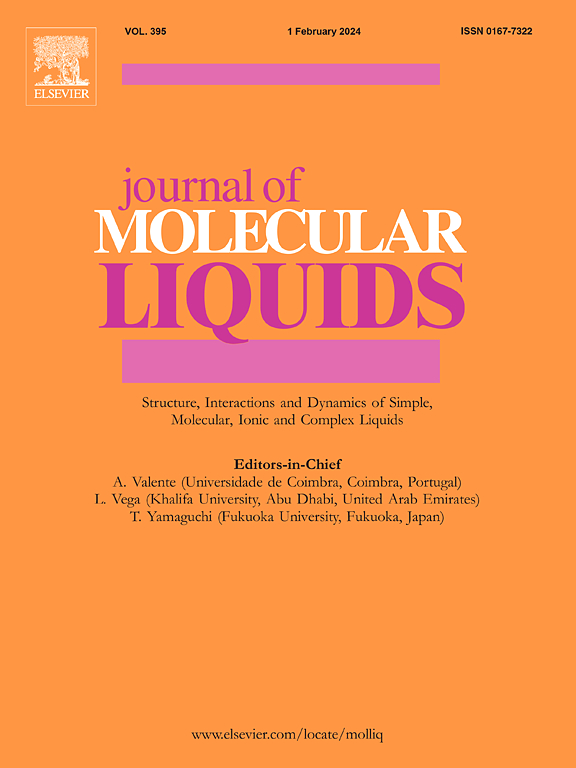Kinetic detection of the geminate ion pair in the super Photoacid 3-Cyano-7-Hydroxycoumarin: excited-state characterization in aqueous and mixed solvents
IF 5.3
2区 化学
Q2 CHEMISTRY, PHYSICAL
引用次数: 0
Abstract
Hydroxycoumarins are aromatic hydroxyl compounds of natural or synthetic origin characterized by multi-state excited state equilibria. 3-cyano-7-hydroxycoumarin (3CN7HC) was here the focus of a comprehensive study of its spectral and photophysical properties in both neutral and anionic forms, together with its model compound, 3-cyano-7-methoxycoumarin (3CN7OMeC). The study was carried out in different solvents at room temperature (293 K) and at low temperature (77 K) in ethanol (neutral, acidic and alkaline), from where all the deactivation rate constants of the singlet (kF, kIC and kISC) and triplet (kPh, and kISC) states could be obtained. In contrast to other coumarins, the two 3-cyanocoumarins exhibited high fluorescence quantum yields solvents (φF = 0.85), with the S1 ∼ ∼∼ > T1 intersystem crossing found to be a negligible deactivation route. The prototropic reactions of 3CN7HC were further investigated in dioxane:water (Dx:H2O) mixtures with molar water fractions (xw) ranging from 0 to 1. In aqueous solution (xw = 1), 3CN7HC undergoes a reversible intermolecular proton transfer to water with pKa = 6.2 and pKa* ≈ 0.5 in the ground and excited states, respectively, making it a super photoacid. The emission spectra showed two bands assigned to the neutral (N*) and anionic (A*) forms of 3CN7HC. While the decays in non-protic solvents (or at alkaline pH values) were mono-exponential, those in Dx:H2O mixtures with xw > 0.5 were triple-exponential, indicating the presence of an additional species. The presence of the tautomeric form (T*) is excluded and the additional species is clearly assigned to the geminate ion pair (A*…H+).
超光酸3-氰基-7-羟基香豆素中双离子对的动力学检测:水溶液和混合溶剂中的激发态表征
羟基香豆素是天然或合成的芳香羟基化合物,具有多态激发态平衡的特征。本文重点研究了3-氰-7-羟基香豆素(3CN7HC)及其模型化合物3-氰-7-甲氧基香豆素(3CN7OMeC)在中性和阴离子形态下的光谱和光物理性质。研究在室温(293 K)和低温(77 K)乙醇(中性、酸性和碱性)溶剂下进行,从中可以得到单线态(kF、kIC和kISC)和三重态(kPh和kISC)的所有失活速率常数。与其他香豆素相比,这两种3-氰香豆素在溶剂中表现出高荧光量子产率(φF = 0.85),其中S1 ~ ~ ~ >;T1系统间交叉被发现是一个可以忽略不计的失活途径。进一步研究了3CN7HC在二氧六环:水(Dx:H2O)混合物中,摩尔水分数(xw)在0 ~ 1范围内的原向性反应。在水溶液(xw = 1)中,3CN7HC在基态和激发态分别为pKa = 6.2和pKa*≈0.5时发生分子间质子向水的可逆转移,成为超光酸。发射光谱显示了3CN7HC的中性(N*)和阴离子(A*)两个波段。在非质子溶剂(或在碱性pH值下)中的衰变是单指数的,而在Dx:H2O混合物中,xw和gt;0.5个为三指数,表明存在额外的物种。排除了互变异构体形式(T*)的存在,并且附加的物种明确地分配给了双离子对(A*…H+)。
本文章由计算机程序翻译,如有差异,请以英文原文为准。
求助全文
约1分钟内获得全文
求助全文
来源期刊

Journal of Molecular Liquids
化学-物理:原子、分子和化学物理
CiteScore
10.30
自引率
16.70%
发文量
2597
审稿时长
78 days
期刊介绍:
The journal includes papers in the following areas:
– Simple organic liquids and mixtures
– Ionic liquids
– Surfactant solutions (including micelles and vesicles) and liquid interfaces
– Colloidal solutions and nanoparticles
– Thermotropic and lyotropic liquid crystals
– Ferrofluids
– Water, aqueous solutions and other hydrogen-bonded liquids
– Lubricants, polymer solutions and melts
– Molten metals and salts
– Phase transitions and critical phenomena in liquids and confined fluids
– Self assembly in complex liquids.– Biomolecules in solution
The emphasis is on the molecular (or microscopic) understanding of particular liquids or liquid systems, especially concerning structure, dynamics and intermolecular forces. The experimental techniques used may include:
– Conventional spectroscopy (mid-IR and far-IR, Raman, NMR, etc.)
– Non-linear optics and time resolved spectroscopy (psec, fsec, asec, ISRS, etc.)
– Light scattering (Rayleigh, Brillouin, PCS, etc.)
– Dielectric relaxation
– X-ray and neutron scattering and diffraction.
Experimental studies, computer simulations (MD or MC) and analytical theory will be considered for publication; papers just reporting experimental results that do not contribute to the understanding of the fundamentals of molecular and ionic liquids will not be accepted. Only papers of a non-routine nature and advancing the field will be considered for publication.
 求助内容:
求助内容: 应助结果提醒方式:
应助结果提醒方式:


